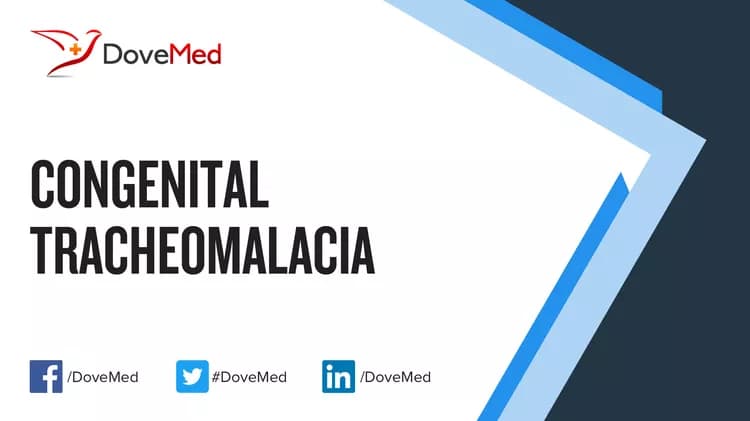What are the other Names for this Condition? (Also known as/Synonyms)
- Primary Tracheomalacia
- Type 1 Tracheomalacia
What is Congenital Tracheomalacia? (Definition/Background Information)
- The trachea is a hollow tube that conducts air from the nose to the lungs and vice versa. It is also known as the windpipe. In a normal child, the trachea is rigid
- Congenital Tracheomalacia is a rare disorder present at birth in which the walls of the trachea are weak and sagging
- When a child with tracheomalacia exhales, the trachea narrows down, causing a great difficulty in breathing. The cartilage surrounding the trachea is not strong enough to hold it
- Normally, a child outgrows the condition by the age of 2 years, when the trachea becomes rigid. Until then, a close monitor of the condition, supportive treatment, and surgical interventions (if required) are used to manage Congenital Tracheomalacia
- The prognosis is generally good, if severe complications or respiratory infections do not develop
There are two types of tracheomalacia, which include:
- Primary or Congenital Tracheomalacia
- Secondary or Acquired Tracheomalacia
Who gets Congenital Tracheomalacia? (Age and Sex Distribution)
- Congenital Tracheomalacia is a rare condition that presents itself at birth
- Both male and female genders are affected
- All races and ethnic groups can be affected
What are the Risk Factors for Congenital Tracheomalacia? (Predisposing Factors)
- Congenital Tracheomalacia is a condition that occurs at birth; the risk factors are currently unknown
- Newborns with this condition typically have an underdeveloped cartilage
It is important to note that having a risk factor does not mean that one will get the condition. A risk factor increases ones chances of getting a condition compared to an individual without the risk factors. Some risk factors are more important than others.
Also, not having a risk factor does not mean that an individual will not get the condition. It is always important to discuss the effect of risk factors with your healthcare provider.
What are the Causes of Congenital Tracheomalacia? (Etiology)
Congenital Tracheomalacia is a disorder that occurs sporadically at birth, with no underlying cause.
What are the Signs and Symptoms of Congenital Tracheomalacia?
The signs and symptoms of Congenital Tracheomalacia can be mild to severe. These include:
- Noisy breathing that changes as the physical position of the child changes; it may get better during sleep
- Breathing problems that becomes worse with coughing, crying, or with other upper respiratory infections (like a common cold)
- High-pitched breathing (stridor)
- A rattling sound may be heard, when the child breathes
- Swallowing difficulties
How is Congenital Tracheomalacia Diagnosed?
For diagnosing Congenital Tracheomalacia the following tests may be conducted:
- Physical examination (also to assess the signs and symptoms) and evaluation of medical history
- Chest X-ray: To check narrowing of the wind pipe, while exhaling
A few other tests may include:
- Airway fluoroscopy - a quick and dynamic study of the entire airway
- Barium swallow is a test that is undertaken to find out the cause for difficulty in swallowing
- Bronchoscopy: It is like an endoscopy, but a bronchoscope is used to visualize the lungs and airways
- CT or MRI scan of the chest
- Lung function tests
- A laryngoscopy may provide helpful information that could aid in the diagnosis of the condition
Note: There are no prenatal diagnostic tests currently available to determine the occurrence of tracheomalacia at birth.
Many clinical conditions may have similar signs and symptoms. Your healthcare provider may perform additional tests to rule out other clinical conditions to arrive at a definitive diagnosis.
What are the possible Complications of Congenital Tracheomalacia?
Congenital Tracheomalacia may present with other congenital defects, developmental delays, and complications, such as:
- Congenital heart defects
- Gastroesophageal reflux disease (GERD)
- Pneumonia, due to aspiration of food particles (aspiration pneumonia)
- Collapse of lung airways (atelectasis of the lungs)
How is Congenital Tracheomalacia Treated?
The child may have to be closely monitored in case any complications or respiratory difficulties are observed. A treatment for Congenital Tracheomalacia may involve the following in a child:
- Providing humidified air
- Maintaining continuous positive airway pressure (CPAP), when the airways are kept constantly open by using a mild pressure
- The child has to be fed carefully, keeping him/her in an upright position after the feed; since, they may have GERD with reflux symptoms
- Physical therapy for the chest
- Administration of antibiotics, to treat any infections
- In very rare cases, surgery (like tracheostomy) may be necessary to correct the defect
How can Congenital Tracheomalacia be Prevented?
Currently, there are no methods available to prevent the development of Congenital Tracheomalacia.
What is the Prognosis of Congenital Tracheomalacia? (Outcomes/Resolutions)
- Typically, the affected child grows out of the condition, between the ages of 18-24 months, in most cases
- However, infants with Congenital Tracheomalacia having respiratory issues should be observed and monitored carefully
- The condition can be fatal, if adequate care and supportive treatment is not provided
Additional and Relevant Useful Information for Congenital Tracheomalacia:
Please visit our Healthy Lungs Center for more physician-approved health information:
Related Articles
Test Your Knowledge
Asked by users
Related Centers
Related Specialties
Related Physicians
Related Procedures
Related Resources
Join DoveHubs
and connect with fellow professionals


0 Comments
Please log in to post a comment.